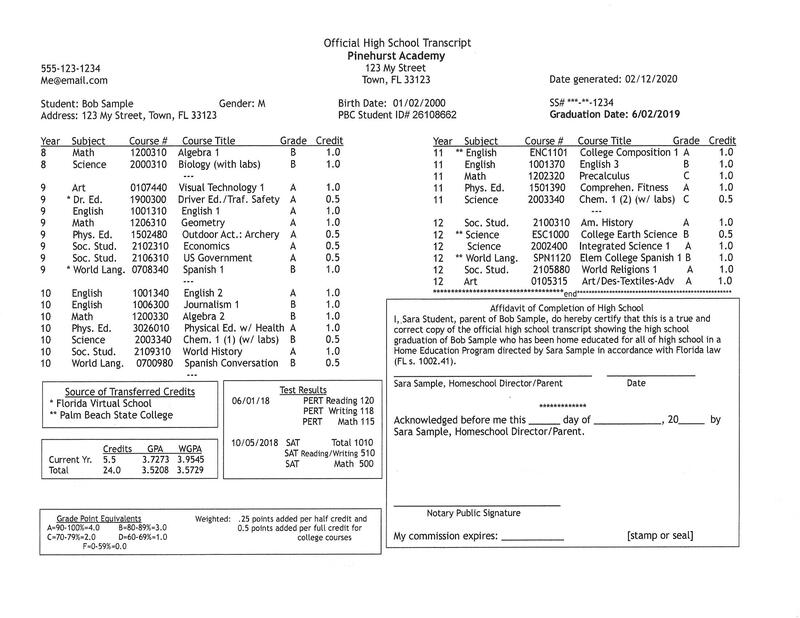Transcripts
Parents who homeschool their own typically write transcripts for their own children when their children need transcripts.
When does a homeschooled child need a transcript? Transcripts do not have to be turned into the school district while homeschooling students. Parents of elementary-aged students may not need transcripts for their children unless ending their homeschooling to register them in a school. Students earning high school credit will want to have transcripts to prove the credits earned when enrolling in schools or colleges. Some extra-curricular activities, such as sports programs, will ask for transcripts to prove academic eligibility. Potential employers may ask for a student's transcript. Cheryl was asked by a potential employer to provide a copy of her high school transcript more than 15 years after graduating from high school, even though she'd earned a college degree and was working on a master's degree. Transcripts can help when a student's homeschooling parent suddenly dies and family members are trying to figure out how to move forward with the child's education. Transcripts should include information for all learning done--including any done at home as well as that done through online learning, co-ops, previous schools, etc. during the homeschooling year or high school years. This page gives information and resources to help parents create transcripts for their own homeschooled children. We do not create transcripts for other families, but we do offer consultations to help parents figure out how to create transcripts and/or to review rough drafts of transcripts and help parents create professional-looking transcripts. If your child is done homeschooling and being enrolled in a school, giving the school a copy of the transcript can smooth the enrollment process. What is a transcript?
Transcript: (noun) a brief (usually one or at most two pages) record of a student's work, showing courses taken and grades achieved
What makes a transcript unofficial?
Unofficial transcripts: Records of student classes and grades that do not include the word "official," are given to a school by a parent not in a sealed envelope, are sent to the school via email directly by the parent or student rather than a school administrator, and/or are on plain paper.
What makes a transcript official?
To be official, a transcript usually includes the word "official" and must be given to the school either in a sealed envelope with a signature or seal across the sealed envelope flap and often inside a second sealed envelope OR is sent electronically to the school by a recognized school administrator; some paid transcript services will send transcripts through an electronic clearinghouse that school officials recognize as official. Notarizing and/or embossing with a seal are other ways to ensure a transcript is accepted as official.
An official transcript should clearly identify the student and school (give a name or list "homeschool"), give names and dates of courses, grades and/or credit earned. Why does it matter if a transcript is official or not?
In most situations, schools and colleges will only accept official transcripts.
How are credits determined for the transcript?
There are several standard methods for determining credits. These are listed below. Choose a method that works best for you. Feel free to use different methods with different courses. (Note that credits are generally a high school thing.)
A. Hours 120 hours of learning = 1 credit. 60 hours = 0.5 credits B. Texts Finishing at least 2/3 to 3/4 of a text meant for a one year high school class = 1 credit. (Schools rarely finish textbooks and therefore cannot expect homeschoolers to finish theirs.) C. Testing If a student passes a test such as a CLEP test or AP test or even a GED practice test in a subject area, it is reasonable to grant 1 credit in that subject. D. Scope and Sequence If a student studies 2/3 to 3/4 of the topics listed in the "scope and sequence" list for a standard, year-long high school class, that would equal one credit. E. Credit earned elsewhere If a student takes a year-long high school-level class at a school or co-op, it may be reasonable to grant one credit. (Though more might be needed if the class meets, say, only once a week for an hour or less and doesn't require outside work. However, it is reasonable to add more to that class at home so the total amount of instruction is worth a credit.) F. College Classes Some college classes are considered equal: One semester of college equals one high school semester, i.e., 0.5 credits. Some college classes earn double credit: One semester of college equals one year of high school credit, i.e., 1 credit; this is typically true of writing, foreign language, and science classes with a separate lab section. See the latest Florida Dept of Education List for recommendation. How are grades calculated?
For your home education program, you decide how the grades are determined. Be realistic so as not to set your student up for failure in the future. You don't have to carefully determine percentage grades for each assignment, weight them, and average them--though you can if you wish. You can grade "holistically" and just assign a letter grade based on what you know of your child's performance, skills, effort, mastery, and such. It can be as simple as thinking about whether the student has been learning as much as you hoped and putting in full effort and using that to estimate a grade.
If the child is being enrolled in a school, the school may use the grade to help decide if the student needs remedial help or advanced classes. |
Many send us a copy of their child's transcript to look over as part of an evaluation or consultation call. Cheryl--former volunteer interviewer for the University of Chicago's admissions committee for 7.5 years Parents can type their students' transcripts on their word processor but many templates are available online to help format transcripts in a professional-looking manner. Some are free; others charge a fee but may calculate the GPA or provide additional services such as use of an official electronic clearinghouse to email records officially or advising services to answer questions.
|
The Affidavit of Completion is a legal statement which should be notarized and is considered legal proof of high school graduation for Florida colleges. Some include the affidavit of completion on a high school transcript after a student graduates. Or use a modified version of it before the student graduates if needed (such as to join the military's Delayed Entry Program). Others make the Affidavit of Completion a separate document. Transcripts may also include brief information about test scores, grading scale, extracurricular activities, etc.
Extracurricular activities can play a larger role in acceptance to a college than most realize so consider counting some activities not as classes with credits earned but as extracurricular activities. Volunteering and work experience can also be helpful. My advice: Don't put too much time and energy into figuring out grades to put on a transcript. While schools and colleges want grades, they won't likely put much faith in them since they have no way of knowing how tough a grader you are; colleges will rely more on test scores, letters of recommendation, and grades from other classes such as dual enrollment classes taken in high school. Proofread your transcript repeatedly and have others proofread it to prevent any errors or inconsistencies that could make your transcript look suspect. Q: Can a Florida public high school reject my child's transcript? A: A Florida public high school, under the Florida Uniform Transfer of Credit Rules, should accept the paperwork from a homeschool parent as long as the student then passes the first grading period in the school. Note that guidance counselors are not always familiar with this rule and may need to be educated on it. This website can help: https://www.flhef.org/transfer-of-credit-rule/ |
|
Homeschool parents are not required to use Florida public school course titles or course codes but using the ones that best match the courses taken at home can help a Florida school or college recognize the classes taken.
The Uniform Transfer of Credit Rule applies to middle and high schools and requires Florida public school to accept at face value official transcripts given them by a parent as long as the student passes the courses in the first grading period at their school. Homeschool parents who want a Florida public high school or middle school to accept their child's previous coursework may need to show the Uniform Transfer of Credit to school officials. |
Home education parents can set their own graduation requirements.
Many choose to follow the public school requirements but parents might choose requirements based on college (or trade school or seminary) admissions requirements, career entry requirements, a passing score on a practice GED (or other) test, skills for independent living, or other criteria. A transcript service, such as the one linked above, offers help in formatting, can send a copy to colleges or schools through an electronic clearinghouse used by public and private schools, and more. This one is run by a homeschooling family. |
Financial aid accounts should be set up not only for student loans, but also for scholarships and grants.
Homeschool parents may choose to send copies of SAT or ACT tests scores and copies of community service hours documentation to the Home Education Contact for their school district for verification for scholarships such as Bright Futures after Federal and Florida Financial Aid accounts are set up.
Get information here about applying for Florida's Bright Futures Scholarship. |








